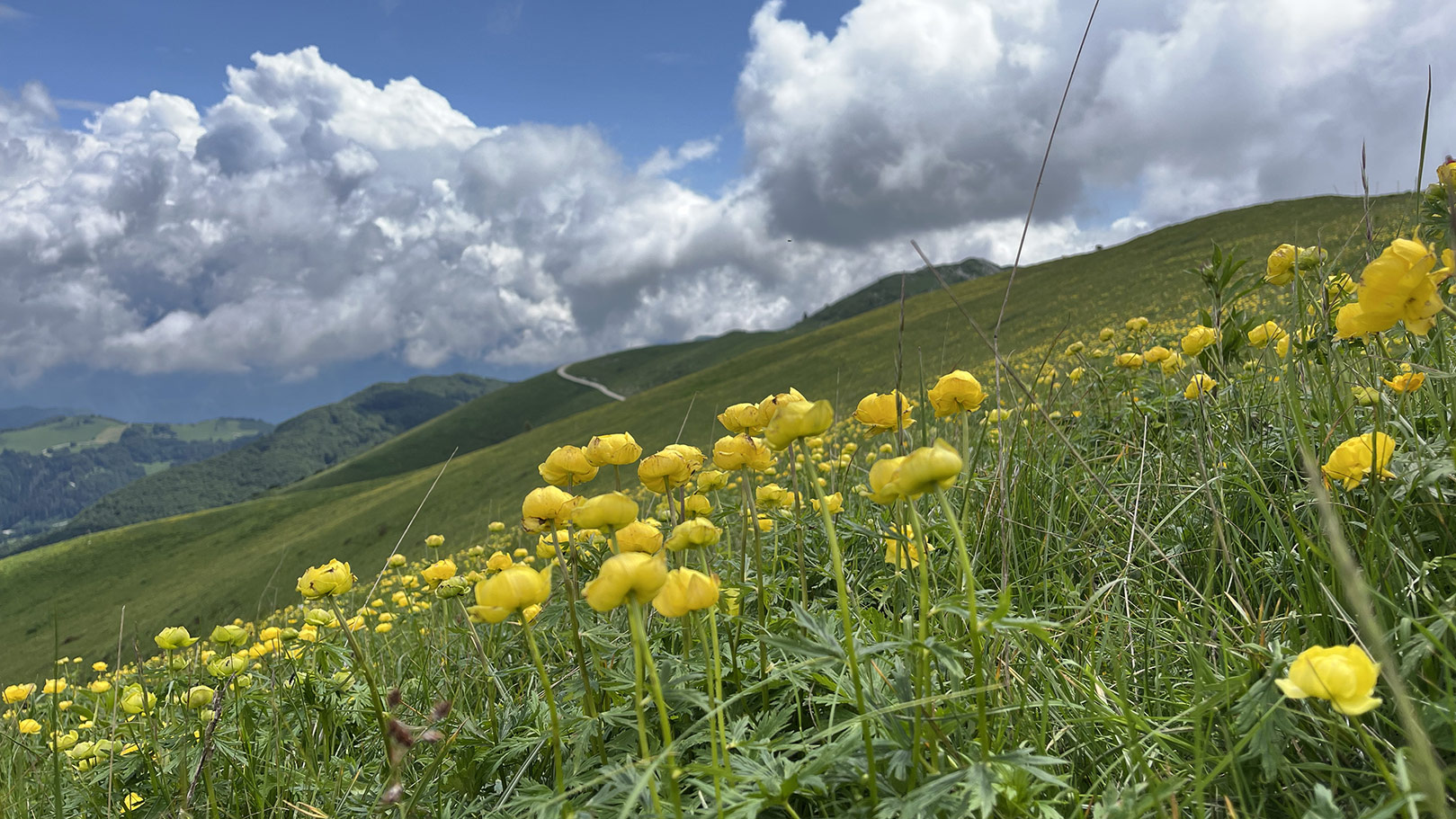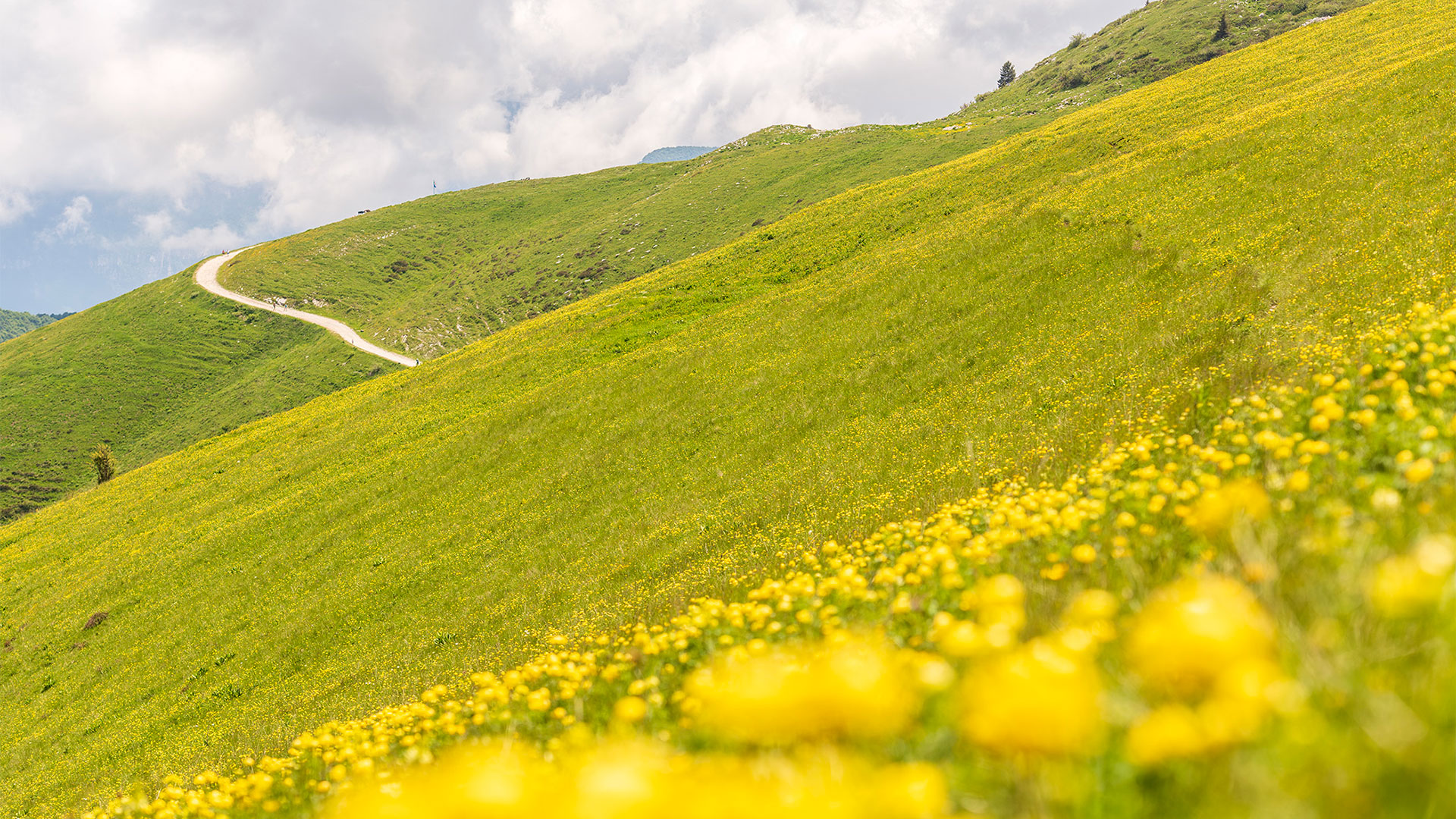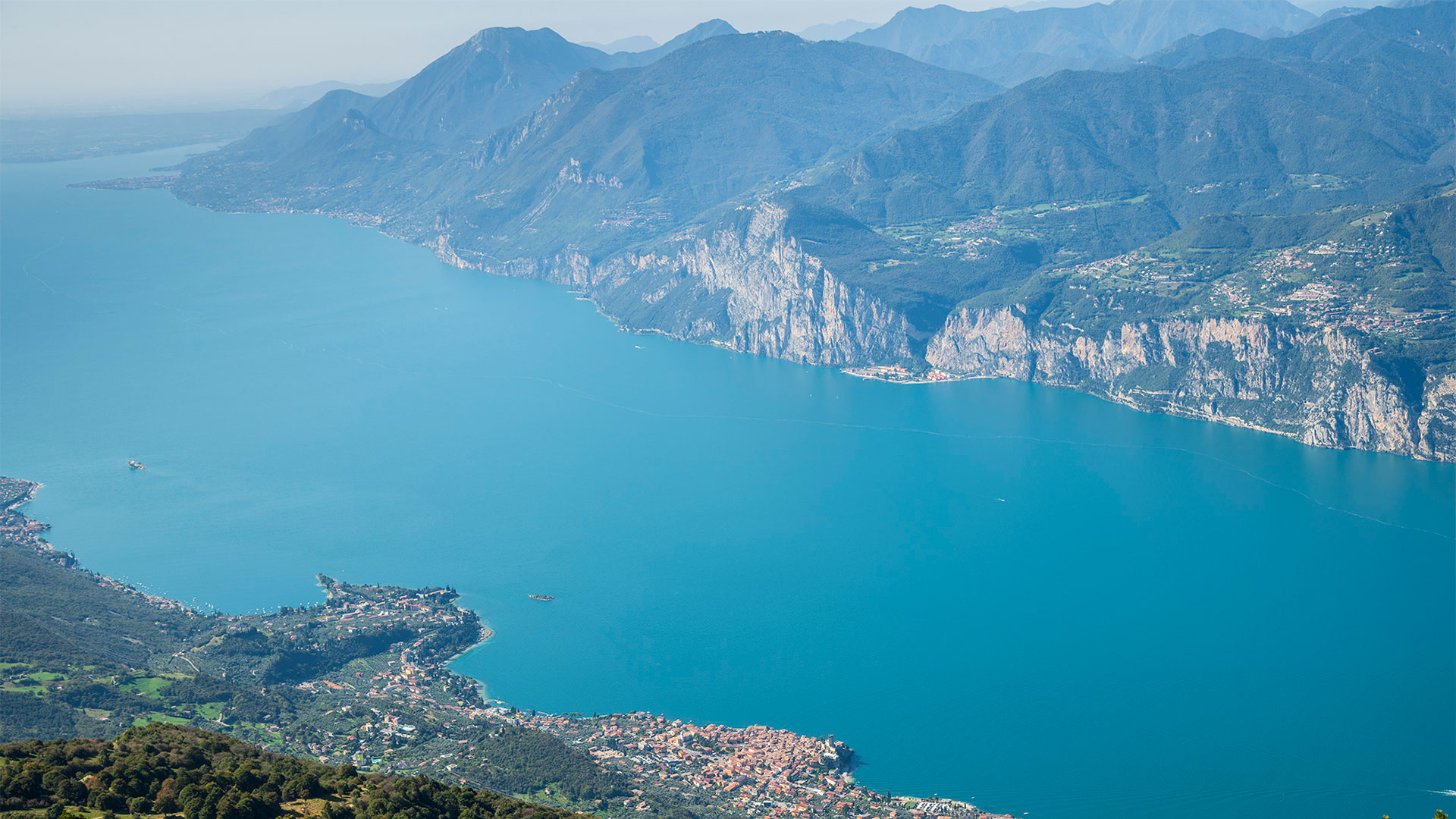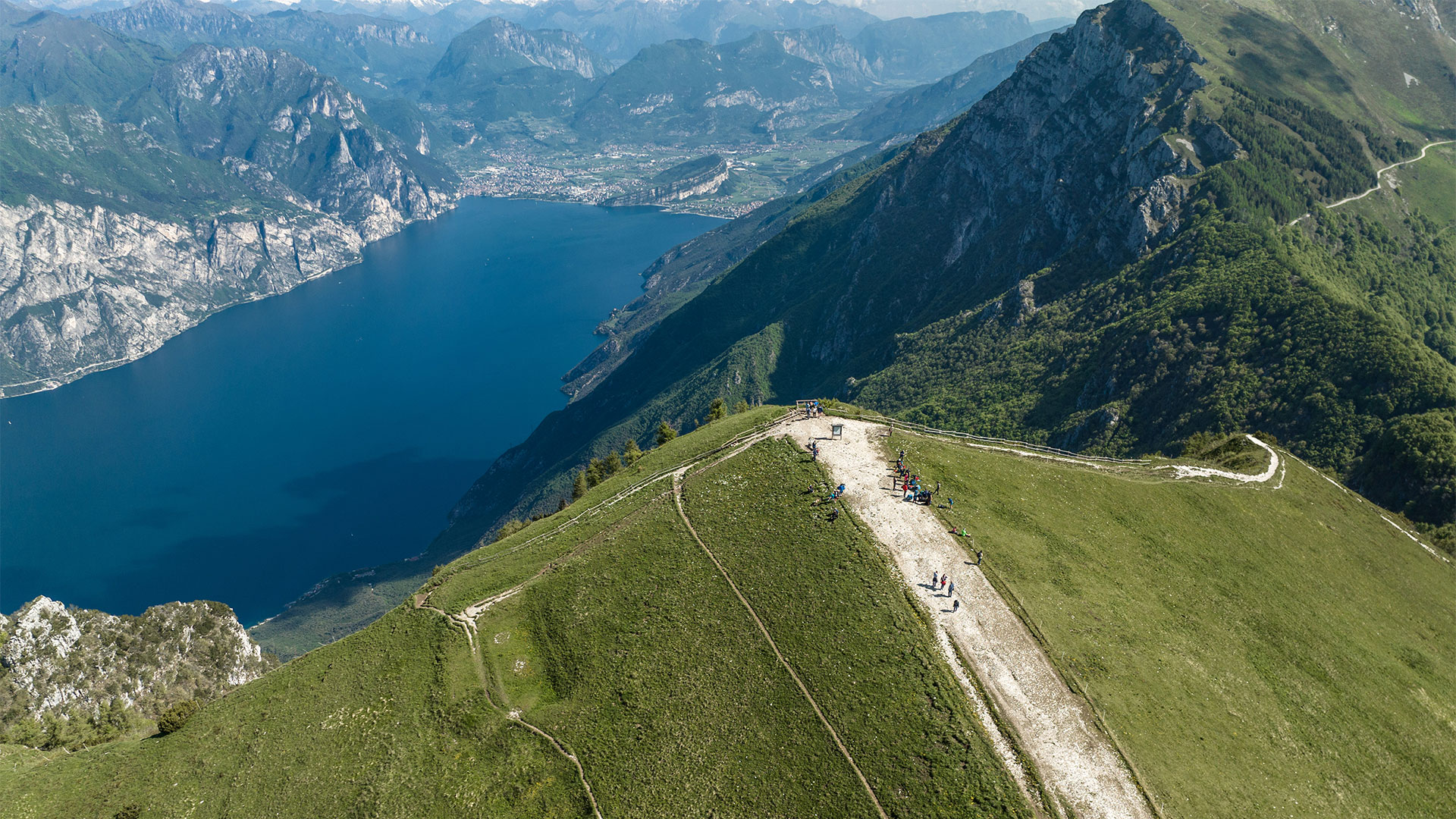Monte Baldo
Monte Baldo has always fascinated anyone who sees it, dominating the surrounding landscape with its magnificence and the imposing height of its 2218-metre high peak, Cima Valdritta and its vastness that encompasses the provinces of Trento and Verona, in the municipalities of San Zeno di Montagna, Ala, Avio, Caprino Veronese, Ferrara di Monte Baldo, Brentonico, Nago-Torbole, Brenzone and Malcesine.
The main ridge of Monte Baldo, which runs from northeast to southeast, winds majestically, revealing natural boundaries and landscapes with enchanting scenery. To the south, the mountain blends into the plain and embraces Caprino Veronese; to the west, Lake Garda forms a similar boundary, accompanying Monte Baldo for 40 km. An enchanting valley unfurls to the north, connecting Rovereto with Nago-Torbole, while to the east is the strikingly beautiful Vallagarina, known as the "gateway to Trentino."
The mountain range reveals its two personalities: the distinctive Monte Baldo and the solitary Monte Altissimo. A succession of impressive peaks, such as the Creste di Naole (1660 m), the Costabella ridge (2062 m), Coal Santo (2072 m), the Buse peak (2154 m), Sascaga peak (2134 m), Telegrafo point (2200 m), Pettorina point (2191 m), Valdritta peak (2218 m), Longino peak (2180 m), Pozzette peak (2128 m), Dos della Colma (1830 m) and Altissimo (2078 m), provide extraordinary views and are a masterpiece of nature.

4 Seasons on Monte Baldo
In winter, Monte Baldo displays all of its majesty, coated in white snow that makes it glitter and turns it into a haven for skiers and snow lovers. When springtime arrives, Monte Baldo dazzles with a striking contrast created by the spring breezes that begin to warm its slopes. The mountain is a living entity that transforms with each passing season. Its captivating allure invites visitors to explore the mountain in its entirety, not only for its breathtaking natural beauty but also for the priceless historical artefacts and geological discoveries it conceals.
The strategic location of Monte Baldo, which rises between the Adige River and Lake Garda, makes it the perfect destination for hikers. Not only can they enjoy an incredible view of the earth and sky from a naturally formed terrace that is easily accessible by cable car, but they can also observe countless rare species of plants and animals.
It is the altitude of the lake that influences the climate, enabling a wide range of natural ecosystems to cohabit, from Mediterranean scrub to hilly land, boreal forest, and Alpine areas. Because of this unique nature, Monte Baldo is known as the Garden of Europe, a true link between the Alps and the Mediterranean.
Flora
With its wide variety of natural settings, Monte Baldo presents an explosion of unique hues and fragrances. Everywhere you look in this earthly paradise, the flora plays the leading role, telling tales of beauty and adaptability. Starting from Malcesine, you will be submerged in the Mediterranean scrub, with its silvery olive orchards, and you will progressively rise through the dense vegetation of the forest to reach the meadows and rocks of the highest peaks, each view a magnificent work of art.
One of the most priceless gems of Monte Baldo's various botanical species is the orchid. There are over 60 different types that adorn the slopes from March to August, depending upon the height at which they grow. Delving even deeper into its vegetation, we come across endemic species such as edelweiss, the magnificent and brilliant red lily, the Monte Baldo anemone, and the wild peony, which paint the mountain with strikingly vivid colours and provide an unforgettable display of biodiversity that validates Monte Baldo's status as the “Garden of Europe”, a bridge that unites the Alps and the Mediterranean.
The expanse of Garda olive trees, which give the environment an iridescent, calming, and perpetual hue against the backdrop of the lake, is seen farther down, behind the belt of pine and beech forests. Cultivated with passion and diligence, they produce a precious oil, full and subtle enough to infuse dishes with the rich and intense aroma of this exceptional Mediterranean condiment. Rarely beautiful flowers, like the solemn red lily, arnica, peonies, and buttercups, blossom spontaneously in the fields used for fodder, as is the case all throughout Mount Baldo. These flowers also make the milk produced by the animals that graze on them more fragrant.
Fauna
In addition to its beautiful flora that covers it with colours and fragrances, Monte Baldo also provides an excellent haven and habitat for the diverse and interesting wildlife that lives there amid the bushes and shrubs. Monte Baldo's wildlife includes numerous bird species that offer captivating aerial and soaring displays, including the golden eagle, kite, tawny and eagle owl to the red woodpecker, hoopoe, pheasant and many others. The mammals that inhabit the mountain range include the badger, which is a rare sight considering its generally nocturnal lifestyle; the fox, weasel, and beech marten; roe deer; the chamois, which rules supreme from the highest peaks; and finally, the marmot, which is almost a symbol of Monte Baldo and will enthrall you with its inquisitive nature.

…e the “malga” tour on Monte Baldo
In addition to its natural marvels, Monte Baldo is home to centuries-old customs like the breeding of sheep and dairy cattle. This is one of the most common and widespread human activities in this amazing location, which maximises the land and the favourable climate brought about by the mountain's advantageous location, which exposes it to an abundance of sunlight.
Here, the malga are small gems nestled in the natural surroundings, where milk is collected and turned into delectable fresh or aged cheeses. Secrets are kept and passed down from generation to generation. These are not only dairy secrets; they also include the raising of pigs to produce excellent meats that are then turned into delectable cold cuts.
The malga (Alpine huts) tour on Monte Baldo is an incredibly stimulating experience. It is a voyage in the name of taste and tradition, of foods made with few ingredients but rich in simple and ancient flavours, enhanced by the beauty of a location where nature coexists with this high-altitude sensory journey.









